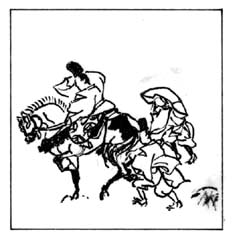|
||
 |
||

(C)2001 Japanese Architecture and Art Net Users System. No reproduction or republication without written permission.
掲載のテキスト・写真・イラストなど、全てのコンテンツの無断複製・転載を禁じます。
|
||||||
| Sano-no-watari 佐野の渡り | ||||||
| KEY WORD : art history / paintings | ||||||
| Lit. crossing the Sano. A historic river crossing often a subject of ancient poetry. The place recorded as Sano 狭野 in Kii 紀伊 province is now considered to be Sano 佐野 in Shinguu 新宮 City in Wakayama prefecture. In ancient times there was a pontoon bridge where the Kinokawa 木の川 flowed into Sano bay, and this was called the Sano crossing. A poem on this topic appears in the MAN'YOUSHUU 万葉集, but the crossing is best known from a poem by Fujiwara no Teika 藤原定家(also read Sadaie; 1162-1241 :SHINKOKINSHUU 新古今集, Winter: #671): koma tomete/sode uchiharau/kage mo nashi/sano no watari no/yuki no yuugure 駒とめて/袖うちはらふ/かげもなし/佐野のわたりの/雪の夕暮 (I have no shelter where I stop my horse/ to brush off from the sleeves/ snowflakes falling fast at Sano/ in the gathering dusk;tran. H.H. Honda). This poem was often pictorialized in *yamato-e やまと絵, with examples extant by Soutatsu 宗達 (? - 1640?) and Ogata Kourin 尾形光琳 (1658-1716), depicting Teika on horseback with a sleeve covering his head. In *ukiyo-e 浮世絵 the figure is usually a young woman in *mitate-e 見立絵 fashion. | ||||||

|
||||||
| REFERENCES: | ||||||
| EXTERNAL LINKS: | ||||||
| NOTES: | ||||||
(C)2001 Japanese Architecture and Art Net Users System. No reproduction or republication without written permission. 掲載のテキスト・写真・イラストなど、全てのコンテンツの無断複製・転載を禁じます。 |
||||||